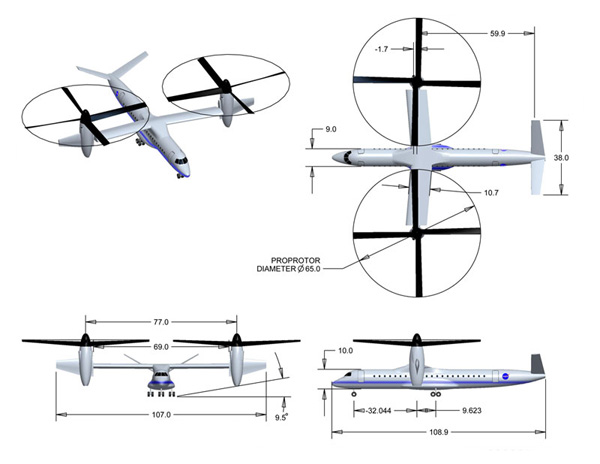NASA Large Civil TiltRotor Concept
Use the mouse to rotate model
The Large Civil Tiltrotor (LCTR), was developed as part of the NASA Heavy Lift Systems Investigation. The concept has since evolved into the second-generation LCTR2, designed to carry 90 passengers for 1000 nm at 300 knots, with vertical takeoff and landing. The general layout and dimensions are shown in Fig. 1.
The LCTR2 is designed to require only helipads located within existing airport boundaries. The operational concept is to move short- and medium-range air traffic off of the main runways, which would free up those runways for use by greater numbers of larger and longer-range aircraft. The use of large VTOL aircraft would thereby improve the capacity of the airspace system as a whole without requiring construction of new runways or expansion of airport boundaries.
The goal of the LCTR2 design studies is to identify research requirements for future tiltrotors. The LCTR2 is sized to be representative of regional jets (90 passengers), convenient for technology investigations. The focus for near-term research is more realistic assessment of technology requirements and potential benefits.
Technology assumptions include reduced rotor tip speed in hover (650 ft/sec), for low noise; a two-speed transmission, for very low cruise tip speed (350 ft/sec), hence high efficiency in cruise; an advanced engine, for low fuel consumption; and advanced composite construction, for low weight. Active load and vibration control is also assumed, leveraging other NASA research. These all present considerable challenges and required detailed assessment of their costs, benefits, and design tradeoffs.
Areas of investigation to date include rotor/wing wake modeling for performance, definition of robust criteria for turn performance, rotor twist and taper optimization, wing/rotor aeroelastic stability, and flight dynamics. Ongoing efforts (early 2012) include optimization of cruise tip speed, including the effects of rotor/wing aerodynamic interference; technology tradeoffs between multi-speed transmissions and variable-speed engines; and simulations of handling qualities during airport operations. The most recent design efforts include comparisons of engines with 2-, 3- and 4-stage power turbines, with fixed and variable geometry. Wind tunnel tests in the Ames 7x10-ft wind tunnel acquired performance and flight dynamics data.
These research activities have involved researchers from multiple NASA centers, including Ames, Langley and Glenn Research Centers, and from the Georgia Institute of Technology, Pennsylvania State University, and the University of Maryland. NASA has also much benefited from technical cooperation with the U. S. Army Aeroflightdynamics Directorate located at Ames Research Center.

Figure 1: The NASA Large Civil Tiltrotor, LCTR2 baseline version (dimensions in feet).
Related Publications
If needed: Download Acrobat Reader
Acree, C.W., "Aeroelastic Stability of the LCTR2 Civil Tiltrotor", AHS Southwest Region Technical Specialists' Meeting, Dallas, TX, Oct 2008. Download
Acree, C. W. Jr.: "Integration of Rotor Aerodynamic Optimization with the Conceptual Design of a Large Civil Tiltrotor." AHS Aeromechanics Conference, San Francisco, CA, January 2010; February 2011, No. 562061. Download
Acree, C. W. Jr. and Snyder, Christopher A.: "Influence of Alternative Engine Concepts on LCTR2 Sizing and Mission Profile." AHS Future Vertical Lift Aircraft Design Conference, San Francisco, CA, January 18-20, 2012. Download
Snyder, C. A. and Acree, C. W. Jr.: "Preliminary Assessment of Variable Speed Power Turbine Technology on Civil Tiltrotor Size and Performance." AHS 68th Annual Forum, Fort Worth, TX, May 1-3, 2012. Download
Acree, C.W., "Aerodynamic Limits on Large Civil Tiltrotor Sizing and Efficiency,"AHS Fifth Decennial Technical Specialists' Conference, San Francisco, CA, January 2014 Download
Point of Contact:
Dr. Wayne Johnson
NASA Ames Research Center
Moffett Field CA 94035-1000